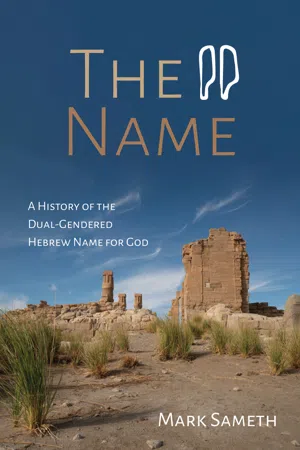![]()
Chapter 1
The Cradle of Civilization Rocked Both Ways: 2700–1400 BCE
A dual-gendered god is so at odds with the image of God we all grew up with that our first reaction may be to dismiss the idea out of hand. To the religious, the thought defies belief. Academics will rightly be skeptical, having in all likelihood heard nothing about it in the academy.
When modern students of the Bible first learn that the ancient Israelites had at one time been polytheistic, they may be surprised but not incredulous. After all, they know that polytheism had, at one time, been the norm. When they learn that some ancient Israelites believed that their masculine God had a female consort—Asherah—once again, they may be surprised, but not incredulous. They know that at one time goddess worship had been the norm.
But that the ancient Israelites might have worshiped a dual-gendered God strikes us as so utterly strange, the concept so utterly unprecedented, that we can be forgiven if we find ourselves unwilling to accept the proposition, no matter how much textual evidence might be marshaled in support of the claim. Indeed, Jews to this day pray to Avinu Malkenu, meaning “Our Father Our King.” Likewise, Christians pray “Our Father Who Art in Heaven.” Muslims refer to Allah as Huwa, grammatically “He.” It seems beyond the realm of possibility that the ancient Israelites—the people who brought Abrahamic monotheistic religion to the world—could have prayed to a dual-gendered God.
That’s why, before we go any further, we need to address this skepticism and feeling that the theory is wrong because it is so unbelievable. Yes, the idea that the Israelites worshiped a dual-gendered god is surprising. But in truth, it would be more surprising if they had not, because in the civilizations surrounding ancient Israel at the time—in both Mesopotamia and in Egypt—belief in dual-gendered deities was, in fact, utterly normative.
Dual-Gendered Gods in Mesopotamia and Egypt
Mesopotamia—literally, the land “between rivers”—has long been called the cradle of civilization. Lying between the Tigris and Euphrates, Mesopotamia was home to the Sumerian, Assyrian, Akkadian, and Babylonian civilizations. Here archaeologists found the earliest evidence of permanent settlements, agriculture, the domestication of animals, and writing.
From as far back as our earliest historical records, beginning around 2700 BCE, and presumably earlier, the religions of Mesopotamia were polytheistic. The names of the deities changed over time as the civilizations of the various peoples who populated the area integrated or gave way one to another. In the Babylonian period, Marduk, the patron god of the city-state Babylon, was elevated to the head of the pantheon.
Marduk was a warrior god, depicted as an expert archer; a thrower of lightning bolts; a sky god who rode across storms in a chariot; a battle-ready fighter; the slayer of the dragon of the primordial sea; and the bêl bêlim, or “lord of lords.” And yet we have this prayer, which may have been addressed to Marduk’s pantheon as a whole but seems, as historian Will Durant put it, “as if uncertain of the sex of the god”:
The most prominent goddess in the Mesopotamian pantheon at the time was gender-bending Ishtar, the name by which she was known to the Babylonians and Akkadians (originally Inanna, she was Astarte to the Greeks). The goddess of both love and war, she was called by the late Assyriologist/Sumerologist Tikva Frymer-Kensky “the goddess who models the crossing of gender lines.” Described as “hero” and “manly,” she “transcends gender polarities and is said to turn men into women and women into men.” At her festivals “men dress as women and women as men, and cultic dancers wear outfits that are men’s clothes on the right, and women’s on the left.” In her Semitic form, such as Ishtar of the Old Babylonian Agushaya Hymn, she is praised for her zikrutu, literally her “manliness.” Needless to say “when she marries she never takes on the jobs of wives” such as making cloth and will never “have to perform any of the domestic duties of ordinary wives.” “Inanna,” Frymer-Kensky declares, “stands at the boundary of differences between man and woman.”
To the south, Egypt, as old as the oldest civilizations of Mesopotamia, also worshiped dual-gendered gods. For instance, Hapi—the Egyptian god who personified the annual flooding of the Nile and hence fertility itself—was depicted as an androgyne: male but full-breasted, seemingly pregnant, and wearing a false beard. Not surprisingly perhaps, given this deity’s dual nature, Hapi was sometimes depicted as a pair of figures.
Other pairs of gods who appear in Egyptian mythology—such as the so-called Ogdoad of Hermopolis, a group of eight Egyptian deities who appear as four male-female pairs—were also understood to be dual-gendered deities, each of whom could manifest in either male or female form: Naunet and Nu, Amaunet and Amun, Kauket and Kuk, and Huh and Hauhet.
A few hundred years before King Solomon built his Temple to yhwh in Jerusalem, the Pharaoh Akhenaten (1353–1336 BCE) built the city Amarna, which he dedicated to Aten, Egypt’s dual-gendered deity whom Akhenaten elevated to supreme god. Scholars continue to debate whether the Aten cult was true monotheism (belief in one god) or rather monolatry (worship of one god). But that the Egyptians believed Aten was of dual gender is not in question. In tomb texts found at Amarna, Aten is referred to as the “mother and father of all creation.” And much has been made of the fact that Aten’s champion, the Pharaoh Akhenaten,...
